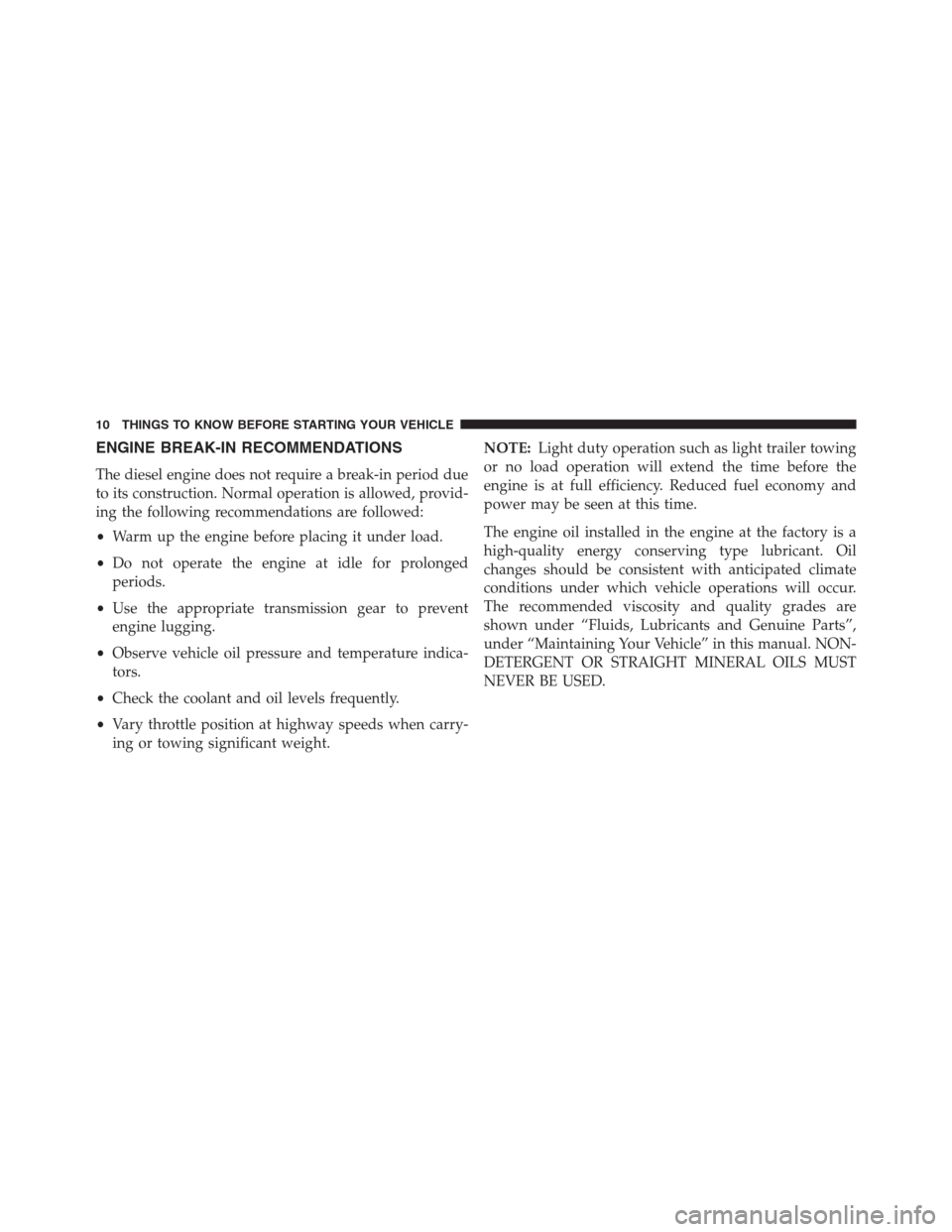Page 12 of 120

ENGINE BREAK-IN RECOMMENDATIONS
The diesel engine does not require a break-in period due
to its construction. Normal operation is allowed, provid-
ing the following recommendations are followed:
•Warm up the engine before placing it under load.
•Do not operate the engine at idle for prolonged
periods.
•Use the appropriate transmission gear to prevent
engine lugging.
•Observe vehicle oil pressure and temperature indica-
tors.
•Check the coolant and oil levels frequently.
•Vary throttle position at highway speeds when carry-
ing or towing significant weight.NOTE:Light duty operation such as light trailer towing
or no load operation will extend the time before the
engine is at full efficiency. Reduced fuel economy and
power may be seen at this time.
The engine oil installed in the engine at the factory is a
high-quality energy conserving type lubricant. Oil
changes should be consistent with anticipated climate
conditions under which vehicle operations will occur.
The recommended viscosity and quality grades are
shown under “Fluids, Lubricants and Genuine Parts”,
under “Maintaining Your Vehicle” in this manual. NON-
DETERGENT OR STRAIGHT MINERAL OILS MUST
NEVER BE USED.
10 THINGS TO KNOW BEFORE STARTING YOUR VEHICLE
Page 72 of 120
Adding Diesel Exhaust Fluid
The DEF gauge (located on the Driver Information Dis-
play (DID display) will display the level of DEF remain-
ing in the tank. Refer to “Driver Information Display
(DID)” in “Understanding Your Instrument Panel” for
further information.
NOTE:Driving conditions (altitude, vehicle speed, load,
etc.) will effect the amount of DEF that is used in your
vehicle.
DEF Fill Procedure
NOTE:Refer to “Fluids, Lubricants, and Genuine Parts”
in “Maintaining Your Vehicle” for the correct fluid type.
1. Remove cap from DEF fill inlet (located in fuel door).
1 — Fuel Fill Location
2 — Diesel Exhaust Fluid Fill Location
Fuel and Diesel Exhaust Fluid Fill Location
70 STARTING AND OPERATING
Page 114 of 120

Adding Engine Coolant (Antifreeze).............90
Adding Fuel..............................65
Air Bag Light.............................21
Air Cleaner, Engine (Engine Air Cleaner Filter).....78
Air Conditioning Filter......................79
Alarm (Security Alarm)......................21
Antifreeze (Engine Coolant)...................89
Capacities.............................96
Disposal..............................92
Anti-Lock Warning Light.....................13
Automatic Transmission
Fluid Type.............................99
Axle Fluid...............................99
Battery.................................87
Brake Fluid..............................99
Brake System.............................94
Fluid Check............................94
Master Cylinder.........................94Warning Light..........................17
Capacities, Antifreeze (Engine Coolant)...........96
Capacities, Fluid...........................96
Caps, Filler
Oil (Engine)............................77
Radiator (Coolant Pressure).................92
Charge Air Cooler.........................94
Coolant Pressure Cap (Radiator Cap)............92
Cooling System...........................88
Adding Coolant (Antifreeze)................90
Coolant Capacity........................96
Coolant Level...........................88
Disposal Of Used Coolant..................92
Drain, Flush, And Refill...................89
Points To Remember......................93
Pressure Cap...........................92
Radiator Cap...........................92
112 INDEX